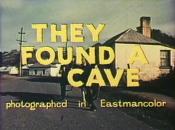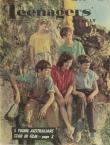AustLit
 9195527756027515771.jpg
9195527756027515771.jpg
Screen cap from opening credits
Adaptation of
They Found a Cave
1948
single work
children's fiction
Issue Details:
First known date:
1962...
1962
They Found a Cave
The material on this page is available to AustLit subscribers. If you are a subscriber or are from a subscribing organisation, please log in to gain full access. To explore options for subscribing to this unique teaching, research, and publishing resource for Australian culture and storytelling, please contact us or find out more.
Latest Issues
AbstractHistoryArchive Description
Evacuated from war-torn London, Cherry and her brothers are sent to live with their Aunt Jandie on a farm in faraway Tasmania. When Jandie is taken ill and sent to hospital, the children are left on the farm under the guardianship of nasty old Ma Pinner, who is disliked even by her own son Tas. The children rebel against Ma Pinner's harsh and spiteful treatment and escape to the secret cave they found while exploring the bush. They later uncover a plot by Ma Pinner to rob their aunt of her farm.
Publication Details of Only Known VersionEarliest 2 Known Versions of
Works about this Work
-
Tasmania and the Cinema
2012
single work
criticism
— Appears in: Senses of Cinema , December no. 65 2012; 'Tasmania's intermittent relationship with the cinema dates back before the first feature film made on its rugged West Coast in 1925, Louise Lovely and Wilton Welch's now lost Jewelled Nights. In many ways what we might call "Tasmanian cinema" reflects the sometimes harsh, depopulated landscape of the island itself. Since the 1920s only a small number of feature films - and a larger number of short documentaries largely made by various state and corporate bodies - have been made or shot in Tasmania, with only the children's film They Found a Cave (Andrew Steane, 1962) standing in for the vast period between Norman Dawn's For the Term of His Natural Life in 1927 and John Honey's remarkable Manganinnie in 1980. But Tasmania also has an interesting place in the global imagination of Hollywood during this period, including its status as the actual birthplace of Errol Flynn, the fabricated place of origin of Merle Oberon, and the largely fantastical landscape of the much-loved Warner Bros. cartoon character, The Tasmanian Devil. Warner Bros.' denial of Flynn's origins, MGM's fudging of Oberon's Anglo-Indian ancestry, and the geographic indistinctness and confusion of the original Tasmanian Devil cartoons, highlight a freer approach to what might be termed the "imagination of Tasmania". (Author's introduction)
-
Tasmania and the Cinema
2012
single work
criticism
— Appears in: Senses of Cinema , December no. 65 2012; 'Tasmania's intermittent relationship with the cinema dates back before the first feature film made on its rugged West Coast in 1925, Louise Lovely and Wilton Welch's now lost Jewelled Nights. In many ways what we might call "Tasmanian cinema" reflects the sometimes harsh, depopulated landscape of the island itself. Since the 1920s only a small number of feature films - and a larger number of short documentaries largely made by various state and corporate bodies - have been made or shot in Tasmania, with only the children's film They Found a Cave (Andrew Steane, 1962) standing in for the vast period between Norman Dawn's For the Term of His Natural Life in 1927 and John Honey's remarkable Manganinnie in 1980. But Tasmania also has an interesting place in the global imagination of Hollywood during this period, including its status as the actual birthplace of Errol Flynn, the fabricated place of origin of Merle Oberon, and the largely fantastical landscape of the much-loved Warner Bros. cartoon character, The Tasmanian Devil. Warner Bros.' denial of Flynn's origins, MGM's fudging of Oberon's Anglo-Indian ancestry, and the geographic indistinctness and confusion of the original Tasmanian Devil cartoons, highlight a freer approach to what might be termed the "imagination of Tasmania". (Author's introduction)
Last amended 26 Sep 2014 10:43:41
Settings:
- Tasmania,
Export this record




